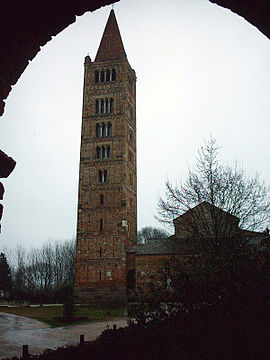Codigoro
| Codigoro | ||
|---|---|---|

|
|
|
| Country | Italy | |
| region | Emilia-Romagna | |
| province | Ferrara (FE) | |
| Coordinates | 44 ° 50 ' N , 12 ° 7' E | |
| height | 4 m slm | |
| surface | 169 km² | |
| Residents | 11,541 (Dec. 31, 2019) | |
| Population density | 68 inhabitants / km² | |
| Post Code | 44021 | |
| prefix | 0533 | |
| ISTAT number | 038005 | |
| Popular name | codigoresi | |
| Patron saint | San Martino | |
| Website | http://www.comune.codigoro.fe.it/ | |

|
||
Codigoro is a small town with 11,541 inhabitants (as of December 31, 2019) in the province of Ferrara in the Emilia-Romagna region in northern Italy .
location
Codigoro is located on an estuary of the Po , the Po di Volano , near the Adriatic Sea. The distance to the provincial capital Ferrara in the west is 43 kilometers by road. Neighboring cities are Mesola in the north and Lagosanto and Comacchio in the south.
history
As can be seen from the Tavola Peutingeriana , the place was called Neroma ('black earth', based on the dark color of the peat soil in the area) in Roman times . In the Middle Ages the place was called Caput Gauri , which means something like 'the place where the Goro branches off'. The courses of the rivers in the Po Delta have changed many times over the centuries, both naturally and as a result of human intervention. In the Middle Ages, the Po di Goro branched off west of Codigoro from the Po di Volano and flowed north past Mezzogoro in a northerly direction, before flowing into the Po di Ariano, a tributary of the Po, at Ariano nel Polesine . Due to silting and drainage measures, this original section of the Po di Goro branching off at Codigoro has now completely disappeared, and only the place names Codigoro and Mezzogoro are reminiscent of the old river bed.
As is proven by numerous documents, the place Codigoro was directly under the abbot of Pomposa in the Middle Ages . The oldest document dates from 1018 and contains the investiture, with which one of the abbots leases some lands to the residents of Codigoro. Within the locality of Codigoro, the abbey had the Domus Dominicata , the administrative and jurisdiction seat for its properties in the region. This building, originally built in the Venetian-Chioggian style, still exists today as a bishop's palace ( Palazzo del Vescovo ), but its exterior was heavily modified in the 18th century through renovations.
In 1224, the Abbot of Pomposa left the municipality of Codigoro to Duke Azzo d'Este and granted him the right to appoint the mayor. In the middle of the 15th century, when the political and cultural charisma and heyday of the Pomposa Abbey were gradually coming to an end, the Abbot of Pomposa asked the Estensi for protection against the raids of the Venetians and for help in warding off the increasing swamping of the region. The dukes initiated drainage measures, among them Borso d'Este in 1464 and - a hundred years later - Alfonso II. D'Este . The construction drawings for the drainage campaigns from 1570 to 1580 were made by the well-known architect Giovanni Battista Aleotti . The drainage measures were only partially successful because subsidence occurred in the drained marshes due to the now higher density of the soil. The drainage measures were also affected by the diversion of the Po delle Fornaci in a southerly direction, forced by the Republic of Venice at the end of the 16th and beginning of the 17th centuries.
The increasing swamping of the area and the spread of malaria resulted in the final economic, political and cultural decline of the Pomposa Abbey and regional civilization. Codigoro was together with the Duchy of Ferrara of the Sub Papal States .
At the beginning of the 18th century, the Roman-German Emperor Joseph I demanded from Pope Clement XI. the return of the county of Comacchio, as it was a former imperial fief that the Papal States illegally appropriated. In 1708 Codigoro was occupied by Austrian troops in connection with this legal dispute. In 1725, Comacchio was returned to the Papal States.
After the invention of the steam engine, the drainage of the area was vigorously pursued with suitable means in 1878. In just a few months, thousands of hectares were drained and converted into arable land. The groundwater level is now regulated with the help of huge high-tech pumping stations.
Population development
The number of Codigoro residents had grown to almost 20,000 by 1951, but has fallen continuously since then. In 2005 only around 13,000 people were counted.
Attractions
- Scariolante Monument ( Monumento allo Scariolante ); a memorial dedicated to the workers who took part in the drainage operations.
- Bishop's palace; a palace on the Cavailotti Riviera, the main street of the city, built during the heyday of Pomposa Abbey and restored in the Venetian style in the 18th century.
- Agrifoglio lock ( Chiavica di Agrifoglio ), oldest lock in the lowlands of the province of Ferrara.
Town twinning
Codigoro maintains a town partnership with the German municipality of Eppertshausen in the Darmstadt-Dieburg district .
Web links
- City administration website (Italian)
- Information about the province of Ferrara (also in German).
Individual evidence
- ↑ Statistiche demografiche ISTAT. Monthly population statistics of the Istituto Nazionale di Statistica , as of December 31 of 2019.
- ↑ A map of the Po Delta from 1599, in which the Goro is drawn, is reproduced in extracts in: Maurizio Paiola: La Casette de Magnavacca - una Delizia Estense ritrovato , Grafis Edizioni, Casalecchio di Reno (BO) 1995, ISBN 88-8081 -041-3 , page 33.

